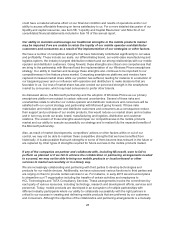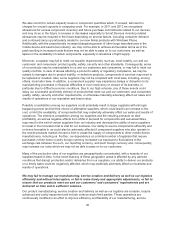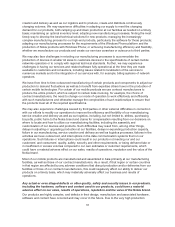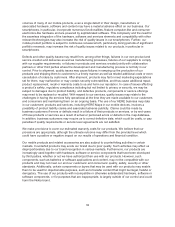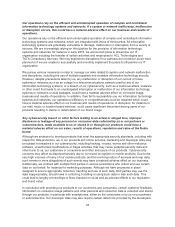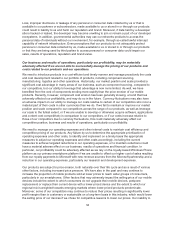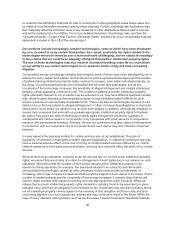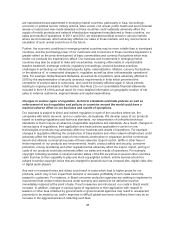Nokia 2012 Annual Report Download - page 37
Download and view the complete annual report
Please find page 37 of the 2012 Nokia annual report below. You can navigate through the pages in the report by either clicking on the pages listed below, or by using the keyword search tool below to find specific information within the annual report.re-routed by the distribution channels for sale to consumers in other geographic areas where sales can
be made at more favorable exchange rates by those channels. Further, exchange rate fluctuations may
also materially affect the US dollar value of any dividends or other distributions that are paid in euro as
well as the market price of our ADSs. For a more detailed discussion of exchange risks, see Item 5A.
“Operating Results—Certain Other Factors—Exchange Rates” and Note 34 of our consolidated financial
statements included in Item 18 of this annual report.
Our products include increasingly complex technologies, some of which have been developed
by us or licensed to us by certain third parties. As a result, evaluating the rights related to the
technologies we use or intend to use is more and more challenging, and we expect increasingly
to face claims that we could have allegedly infringed third parties’ intellectual property rights.
The use of these technologies may also result in increased licensing costs for us, restrictions
on our ability to use certain technologies in our products and/or costly and time-consuming
litigation.
Our products include increasingly complex technologies, some of which have been developed by us or
licensed to us by certain third parties. As the amount of such proprietary technologies and the number
of parties claiming intellectual property rights continue to increase, even within individual products, as
the range of our products becomes more diversified and we enter new businesses, and as the
complexity of the technology increases, the possibility of alleged infringement and related intellectual
property claims against us continues to rise. The holders of patents and other intellectual property
rights potentially relevant to our products may be unknown to us, may have different business models,
may refuse to grant licenses to their proprietary rights, or may otherwise make it difficult for us to
acquire a license on commercially acceptable terms. There may also be technologies licensed to and
relied on by us that are subject to alleged infringement or other corresponding allegations or claims by
others which could impair our ability to rely on such technologies. In addition, although we endeavor to
ensure that companies that work with us possess appropriate intellectual property rights or licenses,
we cannot fully avoid the risks of intellectual property rights infringement created by suppliers of
components and various layers in our products, or by companies with which we work in cooperative
research and development activities. Similarly, we and our customers may face claims of infringement
in connection with our customers’ use of our products and such claims may also influence consumer
behavior.
In many aspects the business models for mobile services are not yet established. The lack of
availability of licenses for copyrighted content, delayed negotiations, or restrictive licensing terms may
have a material adverse effect on the cost or timing of content-related services offered by us, mobile
network operators or third-party service providers, and may also indirectly affect the sales of our mobile
devices.
Since all technology standards, including those we use and rely on, include some intellectual property
rights, we cannot fully avoid risks of a claim for infringement of such rights due to our reliance on such
standards. We believe that the number of third parties declaring their intellectual property to be
relevant to these standards, for example, the standards related to so-called 3G and 4G mobile
communication technologies, as well as other advanced mobile communications standards, is
increasing, which may increase the likelihood that we will be subject to such claims in the future. As the
number of market entrants and the complexity of technology increases, it remains likely that we will
need to obtain licenses with respect to existing and new standards from other licensors. While we
believe that any such intellectual property rights declared or actually found to be essential to a given
standard carry with them an obligation to be licensed on fair, reasonable and non-discriminatory terms,
not all intellectual property owners agree on the meaning of that obligation and thus costly and time-
consuming litigation over such issues has resulted and may continue to result in the future. While the
rules of many standard setting bodies, such as the European Telecommunication Standards Institute,
36




